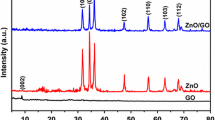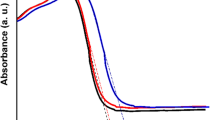Abstract
Photocatalysis is one of the effective methods to treat wastewater and degrade pollutants. Titania (TiO2) is usually chosen based on its superior properties and its high performance as reported in many publications. However, the properties of TiO2 may be influenced by the synthesis method. In this work, several methods were applied to synthesize TiO2, and its modified form (composite with graphene oxide) to explore the influence of synthesis method on its photocatalytic activity for the methyl orange and phenol degradation under UV light illumination. The results showed that the synthesis method significantly influences on the morphology, particle sizes and surface area of the catalysts as examined by SEM and BET techniques but did not differentiate crystal structure and crystallite dimensions of catalysts as seen by XRD measurement. TiO2 catalyst synthesized by hydrothermal method using P123 template was almost anatase phase, possessed high surface area (110 m2/g) and exhibited highest activity for methyl orange and phenol degradation under UV light illumination. However, the addition of graphene oxide to the catalyst is not yet able to improve its activity under visible light. Compared with ZnO-graphene oxide photocatalyst (almost 100% phenol degraded after 275 min of the treatment), TiO2-graphene oxide catalyst exhibited much less activity for methyl orange and phenol degradation under visible light irradiation.










Similar content being viewed by others
References
Liu Y, Zhou S, Yang F, Qin H, Kong Y (2016) Degradation of phenol in industrial wastewater over the F-Fe/TiO2 photocatalysts under visible light illumination. Chinese J Chem Eng 24:1712–1718
Teh C, Mohamed A (2011) Roles of titanium dioxide and ion-doped titanium dioxide on photocatalytic degradation of organic pollutants (phenolic compounds and dyes) in aqueous solutions: a review. J Alloys Compd 509:1648–1660
ldred RN (2001) Chemistry for the graphic arts. Graphic Arts Technical Foundation, USA
Sangeetha R, Basha C (2007) Chemical or electrochemical techniques, followed by ion exchange, for recycle of textile dye wastewater. J Hazard Mater 149:324–330
Rice EW, Baird BR, Eaton AD, Clescerei LS (2012) Standard method for the examination of water and wastewater. American Public Health Association, Washington
Carp O, Huisman CL, Reller A (2004) Photoinduced reactivity of titanium dioxide. Prog Solid State Chem 32:33–177
Chen J, Qiu F, Xu W, Cao S, Zhu H (2015) Recent progress in enhancing photocatalytic efficiency of Tio2-based materials. Appl Catal A 495:131–140
Zaleska A (2008) Doped-TiO2: a review. Recent Pat Eng 2:157–164
Mohamed RM, McKinney DL, Sigmund WM (2012) Enhanced nanocatalysts. Mater Sci Eng R 73:1–13
Serpone N (2006) Is the band gap of pristine TiO2 narrowed by anion-and cation-doping of titanium dioxide in second-generation photocatalysts? J Phys Chem B 110:24287–24293
Guo N, Liang Y, Lan S, Liu L, Ji G, Gan S, Zou H, Xu X (2014) Uniform TiO2–SiO2 hollow nanospheres: synthesis, characterization and enhanced adsorption–photodegradation of azo dyes and phenol. Appl Surf Sci 305:562–574
Khan R, Kim TJ (2009) Preparation and application of visible-light-responsive Ni-doped and SnO2-coupled TiO2 nanocomposite photocatalysts. J Hazard Mater 163:1179–1184
Sharma A, KyuLee B (2017) Growth of TiO2 nano-wall on activated carbon fibers for enhancing the photocatalytic oxidation of benzene in aqueous phase. Catal Today 287:113–121
Sharma A, KyuLee B (2016) Structure and activity of TiO2/FeO co-doped carbon spheres for adsorptive-photocatalytic performance of complete toluene removal from aquatic environment. Appl Catal A 523:272–282
KyuLee B, Sharma A (2015) US patent–US10668458B2_Photocatalyst having high visible-light activity. https://patents.google.com/patent/US10668458B2/en. 02 June 2020
Sheikhnejad O, Feng Z, Rajabtabar A, Khodadad E, Mostofizadeh A, Huang Y (2014) Influence of temperature and surfactant on the photocatalytic performance of TiO2 nanoparticles. Int J Electrochem Sci 9:4230–4240
Estrada-Flores S, Martínez-Luévanos A, Perez-Berumen CM, García-Cerda LA, Flores-Guia TE (2019) Relationship between morphology, porosity, and the photocatalytic activity of TiO2 obtained by sol–gel method assisted with ionic and nonionic surfactants. Boletín de la Sociedad Española de Cerámica y Vidrio. https://doi.org/10.1016/j.bsecv.2019.10.003
Odame-Ankrah CA (2009) Studies of titanium dioxide nanoparticles and surfactants effects, singly and in combinations, on luminescence intensity of some aromatic compounds. Electronic Theses and Dissertations.
Calleja G, Serrano DP, Sanz R, Pizarro P, García A (2004) Study on the synthesis of high-surface-area mesoporous Tio2 in the presence of nonionic surfactants. Ind Eng Chem Res 43:2485–2492
Yu HK, Yi GR, Kang JH, Cho YS, Manoharan VN, Pine DJ, Yang SM (2008) Surfactant-assisted synthesis of uniform titania microspheres and their clusters. Chem Mater 20:2704–2710
Rahimi R, Moghaddas MM, Zargari S, Rahimi R (2013) Synthesis of mesoporous V-TiO2 with different surfactants: the effect of surfactant type on photocatalytic properties. Adv Mater Res 702:56–61
Darzi SJ, Mahjoub AR, Nilchi AAR (2010) Synthesis of spongelike mesoporous anatase and its photocatalytic properties. Iranian J Chem Chem Eng 29:37–42
Mahoney L, Koodali TR (2014) Versatility of Evaporation-Induced Self-Assembly (EISA) method for preparation of mesoporous TiO2 for energy and environmental applications. Mater 7:2697–2746
Qian X, Fuku K, Kuwahara Y, Kamegawa T, Mori K, Yamashita H (2014) Design and functionalization of photocatalytic systems within mesoporous silica. Chemsuschem 7:1528–1536
Mo J, Zhang Y, Xu Q, Yang R (2009) Effect of TiO2/adsorbent hybrid photocatalysts for toluene decomposition in gas phase. J Hazard Mater 168:276–281
Puma GL, Bono A, Krishnaiah D, Collin JG (2008) Preparation of titanium dioxide photocatalyst loaded onto activated carbon support using chemical vapor deposition: a review paper. J Hazard Mater 157:209–219
Bhanvase BA, Shende TP, Sonawane SH (2017) A review on graphene–TiO2 and doped graphene–TiO2 nanocomposite photocatalyst for water and wastewater treatment. Environ Technol Rev 6:1–14
Tayel A, Ramadan RA, El Seoud AO (2018) Titanium dioxide/graphene and titanium dioxide/graphene oxide nanocomposites: synthesis, characterization and photocatalytic applications for water decontamination. Catalysts. https://doi.org/10.3390/catal8110491
Wang X, Hu Z, Chen Y, Zhao G, Liu Y, Wen Z (2009) A novel approach towards high-performance composite photocatalyst of TiO2 deposited on activated carbon. Appl Surf Sci 255:3953–3958
Venkatachalam N, Palanichamy M, Murugesan V (2007) Sol–gel preparation and characterization of nanosize TiO2: its photocatalytic performance. Mater Chem Phys 104:454–459
Hieu NT, Tuy DQ, Phuong PTM, Thang LM (2016) Study on influence of activated carbon category and content in AC/TiO2 catalyst for photodegradation of methyl orange (MO). Vietnam J Chem 54:343–347
Hussin F, Lintang HO, Lee SL, Yuliati L (2017) Photocatalytic synthesis of reduced graphene oxide-zinc oxide: effects of light intensity and exposure time. J Photochem Photobiol A 340:128–135
Divya KS, Xavier MM, Vandana PV, Reethu VN, Mathew S (2017) A quaternary TiO2/ZnO/RGO/Ag nanocomposite with enhanced visible light photocatalytic performance. New J Chem 41:6445–6454
Vanitha M, Keerthi VS, Balasubramanian N (2015) Visible light photocatalysis of methylene blue by graphene-based ZnO and Ag/AgCl nanocomposites. Desalination Water Treat 54:2748–2756
Chang C-W, Hu C (2020) Graphene oxide-derived carbon-doped SrTiO3 for highly efficient photocatalytic degradation of organic pollutants under visible light irradiation. Chem Eng J 383:123116
Sheshmani S, Nayebi M (2019) Modification of TiO2 with graphene oxide and reduced graphene oxide; enhancing photocatalytic activity of TiO2 for removal of remazol Black B. Polym Compos 40:210–216
Wang ZL (2004) Zinc oxide nanostructures: growth, properties and applications. J Phys Condens Matter 16:R829–R858
Gill R, Ghosh S, Sharma A, Nguyen V-H, Vo D-VN, Pham T-D, Kumar P (2020) Vertically aligned ZnO nanorods for photoelectrochemical water splitting application. Mater Lett 277:128–295
Singh H, Kumar A, Thakur A, Kumar P, Nguyen V-H, Vo D-VN, Sharma A, Kumar D (2020) One-pot synthesis of magnetite-ZnO nanocomposite and its photocatalytic activity. Top Catal. https://doi.org/10.1007/s11244-020-01278-z
Chen X, Mao SS (2007) Titanium dioxide nanomaterials: synthesis, properties, modifications, and applications. Chem Rev 107:2891–2959
Raja A, Selvakumar K, Rajasekaran P, Arunpandian M, Ashokkumar S, Kaviyarasu K, Asath Bahadur S, Swaminathan M (2019) Visible active reduced graphene oxide loaded titania for photodecomposition of ciprofloxacin and its antibacterial activity. Colloids Surf A 564:23–30
Fu CC, Juang RS, Huq MM, Hsieh CT (2016) Enhanced adsorption and photodegradation of phenol in aqueous suspensions of titania/graphene oxide composite catalysts. J Taiwan Inst Chem Eng 67:338–345
Malekshoar G, Pal K, He Q, Yu A, Ray AK (2014) Enhanced solar photocatalytic degradation of phenol with coupled graphene-based titanium dioxide and zinc oxide. Indust Eng Chem Res 53:18824–18832
Alam S, Sharma N, Kumar L (2017) Synthesis of graphene oxide (GO) by Modified Hummers method and its thermal reduction to obtain reduced graphene oxide (rGO)*. Graphene 6:1–18
Alemany LJ, Bafiares MA, Pardo E, Martin F, Galan-Fereres M, Blasco JM (1997) Photodegradation of phenol in water using silica-supported titania catalysts. Appl Catal B 13:289–297
Acknowledgments
This research was conducted at the Catalysis Lab, Chemical Engineering of National Taiwan University (NTU) supported by Taiwan MOST Project No.108-2221-E-002-11-MY3, and the RoHan Laboratory of Catalysis supported by the German Academic Exchange Service (DAAD, No. 57315854) and the Federal Ministry for Economic Cooperation and Development (BMZ) inside the framework “SDG Bilateral Graduate school programme”. Nguyen Trung Hieu thanks for a PhD scholarship from RoHan program, and the financial support from NTU.
Author information
Authors and Affiliations
Corresponding authors
Ethics declarations
Conflict of interest
The authors declare that they have no conflicts of interest.
Research Involving Human Participants and/or Animals
The research involved no human participants and/or animals.
Informed Consent
The authors state that the manuscript has not been published or submitted to any other journal.
Additional information
Publisher's Note
Springer Nature remains neutral with regard to jurisdictional claims in published maps and institutional affiliations.
Rights and permissions
About this article
Cite this article
Nguyen, T.H., Vu, A.T., Dang, V.H. et al. Photocatalytic Degradation of Phenol and Methyl Orange with Titania-Based Photocatalysts Synthesized by Various Methods in Comparison with ZnO–Graphene Oxide Composite. Top Catal 63, 1215–1226 (2020). https://doi.org/10.1007/s11244-020-01361-5
Published:
Issue Date:
DOI: https://doi.org/10.1007/s11244-020-01361-5




